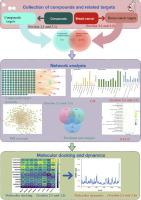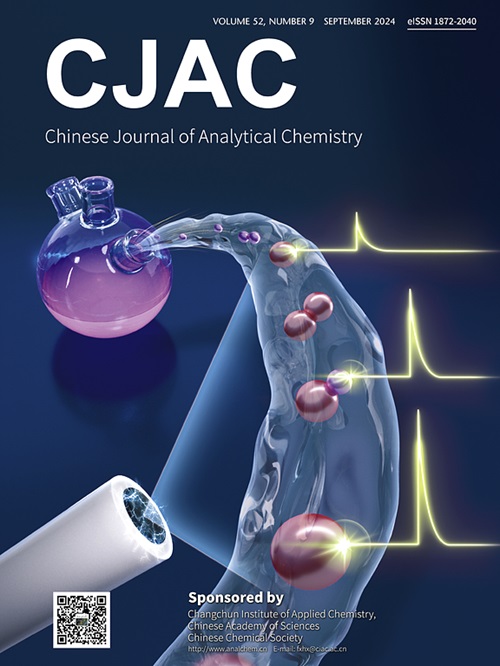通过网络药理学、分子对接和分子动力学模拟,阐明173种潜在乳腺癌治疗药物的分子机制
IF 1.3
4区 化学
Q4 CHEMISTRY, ANALYTICAL
引用次数: 0
摘要
在世界各地,乳腺癌是妇女最常见的癌症之一,被确定为主要的死亡原因。因此,迫切需要开发新的抗乳腺癌药物,以对抗这种致命的疾病,并具有潜在的有效性,这与目前的治疗方法有关。为了解决这一问题,在本研究中,我们首次从科学文献中收集和分析了2021-2024年间尽可能多的173种化合物,通过综合网络药理学、分子对接、分子动力学和分子力学与广义Born和Surface Area溶剂化(MM/GBSA)的综合分析来阐明与乳腺癌相关的潜在分子机制。对所得化合物进行分子性质和药物相似性筛选,探讨其作用机制。通过化合物-靶点网络、蛋白-蛋白相互作用(PPI)网络、基因本体(GO)功能富集和京都基因与基因组百科全书(KEGG)途径富集分析,分析乳腺癌相关的分子机制。随后,我们仔细鉴定了12种潜在活性化合物和192个共同靶点,包括8个相关核心靶点,如PIK3R1、PIK3CB、PIK3CA、PIK3CD、AKT1、AKT2、AKT3和PTPN11。分子对接模拟显示,AKT1-Capivasertib、PTPN11-Olaparib、PIK3R1-(1S)-2-(4-苯基甲氧基苯基)- n-(吡啶-2-甲基)环丙-1胺、PIK3CA-(1S)-2-(4-苯基甲氧基苯基)- n-(吡啶-2-甲基)环丙-1胺、PIK3CB-Capivasertib、akt2 -布洛芬钠、PIK3CD-Capivasertib和AKT3-N-(2-羟基苯基)-2-丙基戊酰胺配合物之间的结合相互作用分别为9.2353、9.2016、8.7742、7.8234、7.7083、7.6387、7.3778和6.6705。通过300 K、200 ns的分子动力学模拟验证了主要研究结果,以强化相关核心靶点与潜在活性化合物之间的分子间机制。此外,计算了8种配合物的总自由结合能,结果表明Capivasertib与PIK3CD具有良好的结合能,结合自由能为- 41.14 kcal/mol。最后,这些结果为理解作用机制提供了新的见解,包括化合物、靶点、有效的生物过程、细胞成分、分子功能和相关途径,这些可能是当前乳腺癌治疗的重要组成部分。本文章由计算机程序翻译,如有差异,请以英文原文为准。

Elucidate molecular mechanisms of 173 compounds for potential breast cancer therapeutics: Insights through integrating network pharmacology, molecular docking and molecular dynamics simulation
All over the world, breast cancer is one of the most common cancers in women and is identified as the prevalent cause of death. Hence, the urgency of developing novel anti-breast cancer drugs for combating this deadly disease with potential efficiency is associated with current therapeutics. To address this issue, in our present work we collected recently analyzed 173 compounds from the scientific literature as much information as possible during 2021–2024 for the first time to elucidate the underlying molecular mechanisms associated with breast cancer via comprehensive analysis that integrates network pharmacology, molecular docking, molecular dynamics, and Molecular Mechanics with Generalized Born and Surface Area solvation (MM/GBSA). Molecular properties and drug-likeness were screened for obtained compounds to probe into the mechanism of action. The compound-target network, protein-protein interaction (PPI) network, Gene Ontology (GO) functional enrichment, and Kyoto Encyclopedia of Genes and Genomes (KEGG) pathway enrichment analysis were performed with the aim of analyzing molecular mechanisms associated with breast cancer. Afterward, 12 potentially active compounds were carefully identified along with 192 common targets, including 8 pertinent core targets such as PIK3R1, PIK3CB, PIK3CA, PIK3CD, AKT1, AKT2, AKT3, and PTPN11. Molecular docking simulations revealed a robust score between AKT1-Capivasertib, PTPN11-Olaparib, PIK3R1-(1S)-2-(4-phenylmethoxyphenyl)-N-(pyridin-2-ylmethyl)cyclopropan-1-amine, PIK3CA-(1S)-2-(4-phenylmethoxyphenyl)-N-(pyridin-2-ylmethyl)cyclopropan-1-amine, PIK3CB-Capivasertib, AKT2-Ibuprofen Sodium, PIK3CD-Capivasertib and AKT3-N-(2-Hydroxyphenyl)-2-propylpentanamide complexes with strong binding interactions of 9.2353, 9.2016, 8.7742, 7.8234, 7.7083, 7.6387, 7.3778 and 6.6705, respectively. The key findings of outcome are corroborated by molecular dynamics simulation at 300 K for 200 ns to reinforce intermolecular mechanism between pertinent core targets and potential active compounds. In addition, overall free binding energy is calculated for eight complexes employing MM/GBSA, and the results indicate that Capivasertib has energetically favourable binding towards PIK3CD with binding free energy of −41.14 kcal/mol. Finally, the light of these results provides new insights into understanding the mechanism of action, including compounds, targets, potent biological processes, cellular components, molecular functions, and pathways involved that may represent an essential part of current breast cancer therapeutics.
求助全文
通过发布文献求助,成功后即可免费获取论文全文。
去求助
来源期刊
CiteScore
3.60
自引率
25.00%
发文量
17223
审稿时长
35 days
期刊介绍:
Chinese Journal of Analytical Chemistry(CJAC) is an academic journal of analytical chemistry established in 1972 and sponsored by the Chinese Chemical Society and Changchun Institute of Applied Chemistry, Chinese Academy of Sciences. Its objectives are to report the original scientific research achievements and review the recent development of analytical chemistry in all areas. The journal sets up 5 columns including Research Papers, Research Notes, Experimental Technique and Instrument, Review and Progress and Summary Accounts. The journal published monthly in Chinese language. A detailed abstract, keywords and the titles of figures and tables are provided in English, except column of Summary Accounts. Prof. Wang Erkang, an outstanding analytical chemist, academician of Chinese Academy of Sciences & Third World Academy of Sciences, holds the post of the Editor-in-chief.

 求助内容:
求助内容: 应助结果提醒方式:
应助结果提醒方式:


